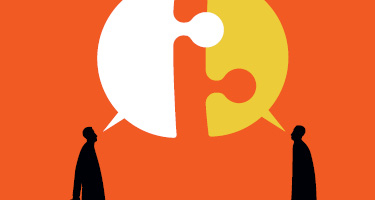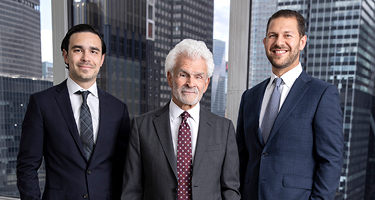AS I ANXIOUSLY headed to law school one overcast morning to turn in my first legal writing assignment, a bus sped through a red light and crashed into the side of my little silver sedan, pinwheeling us around the intersection and crumpling the driver’s side of the car. Thankfully, we were mostly uninjured. In the following months, I experienced the stress and confusion of being a personal injury client—an experience that almost made me want to quit school.
It’s said that all doctors ought to have been patients once; it would improve their bedside manner. The same could be said of lawyers. Things that become second nature to us as practitioners come as a shock and frustration to clients. Different expectations regarding the likely outcome of a case, the case’s timeline and how often they’ll hear from their attorney, for example, are sources of client complaints. I often hear lawyers say clients just don’t get it. Clients “not getting it,” though, is exactly why they need a lawyer—and why lawyers have a job in the first place. Fortunately, these points of contention can be avoided through clear client communication, and lawyers have many practical approaches and tools at their disposal.
A good initial meeting is essential. It might feel a little like teaching a seminar on the legal system and the law but being willing to educate a client now can save you miscommunication, frustration and complaints later. Although many personal injury clients want to know immediately if they have a viable case and how much money they can expect, it’s not possible to give realistic estimates off the bat. This can be difficult for a client to understand.
To manage expectations, AJ Holloway, who practices personal injury near Myrtle Beach, South Carolina, says he and fellow lawyers at the Derrick Law Firm keep a list of items they’ll need to research to show clients how solid their case is and what damages they can claim. Later, if a client has unrealistic expectations, he’ll often show him or her a PowerPoint highlighting key areas of the case—and remind the client, via basketball metaphor, that “this is not a free throw; there’s a whole defense in the way.” He’ll then show what form that defense is likely to take. Derrick Law will also sometimes convene focus groups of 12, mimicking an actual jury, to take some pressure off the lawyers’ opinions. What would these dozen people award the client?
Abby Green, a successful litigation attorney at Grossman Green in Louisville, Kentucky, says such honesty and transparency can build client trust and even earn referrals from clients she doesn’t take. When she has to turn down a case, for instance, Green will validate the client’s misfortune—noting that while the situation is unfair, there are specific facts in the case file and aspects of the relevant law that make the case difficult to prove and possibly not worth the inevitable time and turmoil.
Regarding the timeline, most attorneys expect a case to take much longer than a client does, and they know most will settle and never go to trial. According to the Duke Law School publication Judicature in 2017, “the rate of disposition by trial in civil cases had fallen to less than 2%.” It’s beneficial for a lawyer to explain not just that the timeline always depends, but to clarify what it depends on: the reasonableness of the other side, how quickly the case can get on a trial docket and when the clients themselves decide the case is over. Allison Mabbs, a former prosecutor who works for the defense at MGC Law in Greenville, South Carolina, says she tries to prepare clients for a long wait for trial or conclusion and takes time to outline all steps, letting them know she’ll contact them at each calendar milestone to keep them updated.
Establishing realistic expectations about communication from the outset is of enormous importance, too. During my case, I remember going long stretches without hearing a thing, and feeling forgotten. Many clients worry that their lawyer doesn’t recall details of their case, has lost interest or, worse, forgotten about them and is therefore likely to miss important deadlines. Bear in mind that in general, people do not want to hire a lawyer but are doing so because of a major life problem. This is not your only case, but it is theirs—one surely causing stress and putting a hold on other plans. Knowing when to expect news and hearing from their lawyer regularly can dispel much of clients’ anxiety.
Software such as ProCase, SmartAdvocate, and MessageMedia enable you to schedule regular check-ins with clients and send them text messages—quick notes to say what you worked on that week or what you’re waiting for will go a long way. Amanda Pittman of South Carolina’s McGowan, Hood, Felder and Phillips—she was listed in Best Lawyers: One to Watch in America in 2022 for plaintiffs’ personal injury—is an experienced advocate but did not come from a line of attorneys, which gives her a great advantage. Imagining exactly what her family would expect from a case, and which terms they’d recognize and understand when speaking to their attorney, helps her communicate better and manage expectations. Although she makes clear how much the client will likely communicate with other members of the firm, such as the paralegal, “the attorney signs the fee agreement, and if they want to speak with me, I feel like that’s my job.” Regular communication with clients is Rule 1.4 in the American Bar Association’s “Model Rules of Professional Conduct.” “When so many grievances are filed over not responding to clients,” Pittman says, “why even take that risk?”
Green likewise says most clients “just want to feel heard.” If after your initial meeting you feel like your client constantly needs to vent, though, you could offer them the advice Holloway does to some of his: “Try to live your life as if you do not have litigation.” This prepares clients for being able to handle both their emotions and expenses. (You might also want to network with a good therapist to recommend to clients as someone who can listen to them without taking time away from working on their case.)
In general, it may be wise to follow an old business adage popularized by Tom Peters, the management guru: “under promise and overdeliver.” To get personal injury clients in the door and their signature on a representation agreement, overpromising can be tempting. In many jurisdictions, lawyers are permitted to feature client settlements in ads but not to claim that they can achieve the same for any new client. Regardless, in these initial meetings, expectations are generally high, language positive and attitude confident.
What’s more, some lawyers don’t sufficiently explain their commission or clarify that it’s tallied after expenses. Many clients therefore feel that the longer their case goes on, the less enthusiastic the representation—and some end up shocked by the difference in what their lawyer talked about at the outset and what they urge the client to accept during settlement talks. As a first-time client and law student, I certainly felt as though what was said in the first meeting in no way resembled later communication or the ultimate result. Lawyers in search of positive reviews and referrals would be well to remember Peter’s advice.
In the end, clients and lawyers can have vastly different expectations regarding the duration of the case, the frequency of communication and the outcome. If the lawyer is honest and upfront about this in the initial meeting, stays in touch and validates a client’s feelings, potential disagreements and other friction can be minimized, thereby saving the adversarial relationship for the courtroom—not the client.
Paula Birch Billingsley is a lawyer, mother and writer in South Carolina. She received her JD from University of South Carolina and Masters in English from Mercy College, NY, and lives in South Carolina with her family, two dogs and three cats.
































